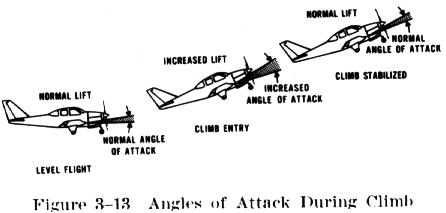
For an automobile to go uphill at the same speed that was being maintained on a level road, the driver must "step on the gas;" that is, power must be increased. This is because it takes more work to pull the car's weight up the hill and to maintain the same speed at which the car was moving along the level road. If the driver did not increase the power, the automobile might still climb up the incline, but it would gradually slow down to a speed slower than that at which it was moving on the level road.
Similarly, an airplane can climb at the cruise power setting
with a sacrifice of speed, or it can, within certain limits, climb with
added power and no sacrifice in speed. Thus, there is a definite relationship
between power, attitude, and airspeed.
| When transitioning from level flight to a climb, the forces acting on the airplane go through definite changes (Fig. 3-13). The first change, an increase in lift, occurs when back pressure is applied to the elevator control. This initial change is a result of the increase in the angle of attack which occurs when the airplane's pitch attitude is being raised. This results in a climbing attitude. When the inclined flightpath and the climb speed are established, the angle of attack and the corresponding lift again stabilize at approximately the original value. |  |
As the airspeed decreases to the climb speed, the downward force of the air striking the horizontal stabilizer becomes less, creating a longitudinally unbalanced condition which produces a tendency for the airplane to nose down. To overcome this tendency and maintain a constant climb attitude, additional back pressure must be applied to the elevator control.
The primary factor which affects an airplane's ability to climb is the amount of excess power available; that is, the power available above that which is required for straight and level flight. During the climb, lift operates perpendicularly to the flight path, so that it is not directly opposing gravity to support the airplane's weight. With the flightpath inclined, the lift is partially acting rearward - creating what is termed induced drag. This adds to the total drag. Since weight is always acting perpendicular to the earth's surface, and drag is acting in a direction opposite to the airplane's flightpath during a climb, it is necessary for thrust to overcome both drag and gravity.